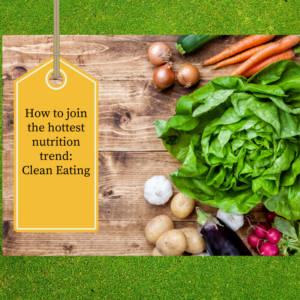How to join the hottest trend in nutrition – Clean Eating!
Clean Eating Movement
As a seasoned Dietitian, I’ve seen food trends come and go. From the Cambridge diet to the South Beach diet or the perennial cabbage soup diet – there is always an “it” diet of the year.
Earlier this year, over 400 Registered Dietitian Nutritionist completed the fourth annual 2016 “What’s Trending in Nutrition?” survey. The results showed ancient grains holding their place with seeds sneaking up as an up and coming stars with “Clean Eating” making the top of the list.
This matches the conversations I’ve been having with women lately since they more frequently say “I try to eat clean, at least during the week, you know what I mean?” Unfortunately, I don’t. You see there is no standard nutrition definition for eating clean.
Nutrition and ambiguity have become reluctant partners over the past decade. Nowhere is this more evident than when defining clean eating.
Does Clean Eating equal a Clean Life?
According the book “Clean Eating for Dummies©” the following definition of clean eating includes:
Clean eating is often described as eating foods that are whole, unprocessed, and as close to the way they were grown in nature as possible.
Clean eating plans limit foods and beverages with artificial ingredients, refined flours, and added sugars. The soul of eating clean is consuming food the way nature delivered it, or as close as possible.
Clean eating is not a diet; it’s an intentional lifestyle approach to eating, its selection and preparation – one meal at a time.
Clean eating is not embraced so much for weight loss but for gaining health benefits.
The result is often unintentional modest weight loss as one moves from boxed, bagged, tinned foods to whole fruits, veggies, nutrient-endowed grains, and meats, fish and fowl humanely raised, fed, and prepared for consumption.
Entering the world of Clean Eating
You’ve decided it’s time to become a clean eater. What’s the first step?
With over 42,000 food items available at the average grocery store today, choosing foods that fit the “clean eating” bill becomes a daunting task.
First, look at your life (family, work, food budget) and compared to the basic definition of clean eating, what or which aspects of clean eating can you embrace without creating additional stress?
Purchasing organic fruits and vegetables is an easy start. However, buying all organic will impact your food budget. Would it be possible to look at the vegetables/fruits you (your family) eat the most and purchase these organically grown?
The bottom line, it’s always wiser to eat any vegetables, organic or conventionally grown, than limit yourself to only organically grown foods.
Which claims should you look for?
The 2016 IFIC Food & Health yearly survey posed the question “How do you define healthy food?” More than 35% of respondents stated “does not contain or has low levels of certain food components.” This trend is the reason that front package claims appear to have a laundry list of “free-from” claims or the use of the term “free-range” on eggs and chicken.
When shopping for whole and unprocessed foods, it’s important to look past the front of the package, where the marketing claims scream for your attention. It’s more important to turn the box over and read the list of ingredients.
The advice that the label shouldn’t have more than 5 ingredients is not set in stone. Instead, look at the label and ask yourself “can I purchase these ingredients in the store?” Try to match up the ingredient list with how you would make this dish from scratch is helpful when comparing soups, broths, and main-meal dishes.
Food companies have responded to the clean eating phenomenon by enticing consumers with the “free from” label. Removing ingredients, like gluten, high-fructose corn syrup, GMO’s, antibiotics and additives.
However, claims of free-from this or that is not synonymous with good for you foods. Free-from labels can give foods a “health halo” giving people the green light to over indulge in these “free-from whatever” snacks and dessert foods.
Clean Eating or Food-Shaming?
I’ve been to yoga-centric activities that include food and the conversation always goes to clean eating. These informal conversations have come up with statements like “I eat clean, only buy organic, don’t you? Their look of astonishment that I don’t buy every fruit and vegetable organic is an opportunity for me to share why I don’t.
My 35 years as a Registered Dietitian Nutritionist, allows me to cull from science-based research combined with real-life nutrition education events that reveals people have a desire for black and white answers when it comes to food choices.
I’ve heard “just tell me what to eat” so many times in my lifetime that hearing it evokes the “nails scratching the black board” effect – I want to put my hands over my ears!
My concern with the clean eating movement is that it can evoke judgment on those that don’t claim this as their health mantra. Embracing the major pillars of clean eating needs a robust food budget as organic produce and organic-fed proteins are higher priced.
Clean eating frowns on using anything out of a box or bag which means enough discretionary time to prepare meals from scratch. Frozen vegetables can be dismissed as inferior when food science has elevated frozen veggies to be on par or even superior to fresh counterparts.
Embracing clean eating means creating an eating environment (i.e. family and other eating partners) that support and enjoy the tenets of clean eating too.
Will the Clean Eating Movement Continue?
I am happy to see this movement since it opens the conversation on how to get more vegetables into the diet; it brings an awareness of the foods we select, no matter the reason for the awareness, and the clean eating movement provides an alternative to fad diets, which is always a good thing.
However, I believe the clean eating movement is an iteration created out of the frustration felt from the results of following traditional “diets” and fueled by social media’s ability to showcase highly photogenic fresh food dishes.
The clean eating movement is promulgated by nutrition/wellness bloggers and stimulated by marketer’s savvy food message labeling, motivated by the desire to feel and look healthier.
I also believe that the movement is energized by societies need to be part of a tribe with flickers of elitist sentiments coupled with an authentic desire to foster a healthier way of eating for self, family, and the world.
If you’re part of the clean eating movement, kudos to you for taking power over your eating lifestyle. My wish is that you focus on intentional food and eating decisions based on what keeps you and your family feeling great and happy without becoming the “dinner dictator.”
If you’re thinking about eating cleaner, tell me what step you plan to take to begin this journey.
Not sure of where to start? Start by contacting me for a free session.
Bonnie is a Registered Dietitian Nutritionist, Certified Health and Wellness Coach, and Hormone Support Coach that creates results-driven, health promoting programs for women.

